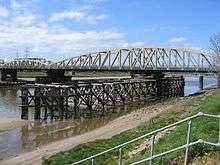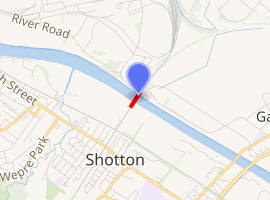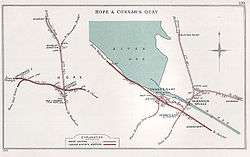Hawarden Bridge
Hawarden Bridge (/ˈhɑːrdən/; Welsh: Pont Penarlâg) crosses the River Dee, near Shotton, Flintshire, Wales. The bridge was built by the Manchester, Sheffield and Lincolnshire Railway (later the Great Central Railway), on the Chester & Connah's Quay Railway. It opened on 3 August 1889.
Hawarden Bridge | |
|---|---|
 | |
| Coordinates | 53.2172°N 3.0332°W |
| Carries | Borderlands Line |
| Crosses | River Dee |
| Locale | Deeside |
| Official name | Hawarden Bridge |
| Maintained by | Network Rail |
| Characteristics | |
| Design | Swing bridge |
| Longest span | 85 m (279 ft) |
| No. of spans | 3 |
| History | |
| Designer | C. A. Hobson |
| Construction start | 16 August 1887 |
| Opened | 3 August 1889 |

| |

Hawarden Bridge is on the Borderlands Line between Wrexham to Bidston. Hawarden Bridge railway station is on the north side of the bridge and Shotton station is on the south. National Cycle Route 5 crosses the Dee on the bridge on a path adjacent to the railway line.
On opening, Hawarden Bridge was largest swing bridge in the United Kingdom.[1] The highest temperature recorded in Wales, 35.2 °C (95.4 °F), was recorded at the bridge in August 1990.[2] In the 2010s, the bridge was restored enabling speed and axle load limitations to be raised. It is a Grade II listed structure.[1]
History
In the 1880s, the Manchester, Sheffield and Lincolnshire Railway built the line between Chester Northgate and Hawarden Bridge Junction.[1] It crossed the River Dee on a 540-foot-long (160 m) bridge. The Board of Trade, advised by Sir George Nares, required that the bridge's opening span was at least 140 feet (43 m) wide to allow ships to pass through. In 1886, an Act of Parliament was obtained for its construction.[3]
The civil engineer C. A. Hobson designed the steel bridge that was constructed by John Cochrane & Sons.[4] Construction took about two years and cost around £70,000. To overcome challenging conditions of the estuary, its foundations were built in brick-lined wells as directed by the project's chief engineer, Frances Fox.[5] The bridge was opened to traffic on 3 August 1889 by Catherine Gladstone, the wife of Prime Minister William Ewart Gladstone[1][6] who laid the first cylinder in the river in an earlier ceremony to mark the commencement of construction.[5]
Hawarden Bridge's central section, Span 10, contained the swing bridge. As built, it rotated through 90-degrees to enable the passage of tall ships. The 85-metre (279 ft) section weighed 764 tonnes (752 long tons) and took 40 seconds to move between its closed and open positions.[1] The moving span was controlled from a manned tower next to the bridge which was demolished in 1976.[7] When built, it had the largest opening span of any swing bridge in the United Kingdom.[3]
The bridge no longer opens, the span was welded shut. The last time it opened was in 1960 after it was made redundant by the absence of tall ships.[1] The remains of the rotating mechanism – hydraulic cylinders attached to a drive chain and sprocket – are visible beneath the bridge but the pumping stations and the steam engines used for powering it have been removed.[1]
The wings of the Airbus A380 are transported on barges along the Dee three times per week from the Airbus factory at Broughton. They pass under the bridge before reaching the port of Mostyn where they are loaded onto larger seafaring vessels.[1]
Pedestrians and cyclists can cross the bridge via a walkway connecting the Wales Coast Path and the Chester Greenway Railway Path section of National Cycle Route 5. The walkway is the responsibility of Sustrans Cymru.[8] In late 2003, improvements to the walkway were completed; it was widened so that mounted cyclists could pass pedestrians and cycle ramps were installed at both ends.[6]
Exposure to the harsh conditions on the Dee Estuary for over one hundred years, degraded the condition of the bridge.[1] Corrrosion caused by saltwater and weather degraded the bridge. Restrictions were imposed on rail traffic, axle loading was limited to RA7, a maximum speed of 20 mph (32 km/h) was imposed and only the one track could loaded at one time. Network Rail said fewer restrictions would be imposed if the bridge was strengthened to justify an RA10 rating.[1] In 2009, councillors became concerned about cracks in the bridge's supporting brickwork. An inspection by Network Rail determined it was safe and the damage was largely aesthetic.[9]
The bridge was strengthened and restored in the 2010s.[10][11] The work was carried out in two phases, strengthening was carried out before the erection of the soffit scaffolding, followed by abrasive blasting and repainting. Aluminium scaffolding was used because the bridge was not strong enough to support heavier steel scaffolding. The bridge remained open to river and rail traffic throughout. A 5 mph (8 km/h) speed limit was imposed on the bridge due to the tight clearances involved.[1] Restoration, completed on 12 November 2014, cost of £8 million and involved installing 130 tonnes of steel, 12,000 tension control bolts, and took more than 85,000 man hours. The bridge was given a RA10 rating was and operational restrictions were removed.[1][12]
References
Citations
- Johnson, Marc. “Hawarden Swing Bridge.” Rail Engineer, 16 February 2015.
- Edben, Philip. “Weather in Wales – The Welsh Climate.” The Daily Telegraph, 29 May 1999.
- Fox, Francis. “The Hawarden Bridge.” Institute of Civil Engineers (ICE), Volume 108, Issue 1892, 1892. pp. 304-317. PART 2. E-ISSN 1753-7843.
- "Disused Stations:Hawarden Bridge". www.disused-stations.org.uk. Retrieved 10 July 2018.
- “Hawarden Bridge.” shotton-tc.co.uk, Retrieved: 30 July 2018.
- “Dee-light at crossing revamp.” dailypost.co.uk, 24 October 2003.
- “A History of Sealand — the community that rose from the sea.” sealandcommunitycouncil.gov.uk, Retrieved: 30 July 2018.
- “Hawarden Bridge is closed today to cyclists and walkers on for essential maintenance.” deeside.com, 13 December 2016.
- “Rail bosses reassure Hawarden bridge is safe.” The Chester Chronicle, 23 July 2013.
- “Major work to strengthen Hawarden railway bridge completed.” Network Rail Media Centre, 14 November 2014.
- Doman, Robert. “£8m scheme restores Hawarden bridge to former glory.” leaderlive.co.uk, 13 November 2014.
- “Hawarden Swing Bridge.” AMCO, Retrieved: 30 July 2018.
External links
- Hawarden Bridge and Dee Marsh (photographs by David Sallery)
- Photographs from BBC
- Central section photo